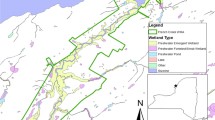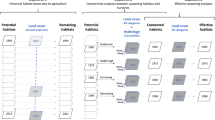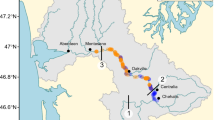Abstract
We examined if restored connectivity within a freshwater coastal wetland, dominated by invasive Typha x glauca, can increase the ecological condition, as assessed by a Floristic Quality Index (FQI), and improve habitat to benefit northern pike (Esox lucius) reproduction. Using an aquatic excavator to simulate natural rivulets, channels were excavated within monotypic Typha stands to create a link to upslope wet meadows. Following excavation, we found channels were rapidly colonized by native vegetation, resulting in higher FQI scores and percent cover of short-emergent vegetation compared to natural reference channels. Excavated channels also retained a community of vegetation with more native species five years following excavation. Fish emigration surveys revealed that excavated channels functioned as early-life habitat and had higher abundances of young-of-the-year northern pike than reference channels. A seven-year dataset (2011–2017) of northern pike outmigration at channel connectivity and pothole complexes was strongly related to water level conditions during the spawning and emigration period. We conclude that the enhancement methods increased the ecological condition of the vegetation community (i.e., FQI) suppressed by invasive Typha while the associated northern pike reproductive success highlights the importance of habitat connectivity and periodic flooding within coastal wetlands.










Similar content being viewed by others
References
Bates D, Maechler M, Bolker B, Walker S (2015) Fitting linear mixed-effects models using lme4. Journal of Statistical Software 67:1–48
Boers AM, Zedler JB (2008) Stabilized water levels and Typha invasiveness. Wetlands 28:676–685
Boers AM, Veltman RLD, Zedler JB (2007) Typha x glauca dominance and extended hydroperiod constrain restoration of wetland diversity. Ecological Engineering 29:232–244
Bourdaghs M, Johnston CA, Regal RR (2006) Properties and performance of the floristic quality index in Great Lakes coastal wetlands. Wetlands 26:718–735
Bried JT, Strout KL, Portante T (2012) Coefficients of conservatism for the vascular flora of New York and New England: inter-state comparisons and expert opinion bias. Northeastern Naturalist 19:101–114
Bry C (1996) Role of vegetation in the life cycle of pike. In: Craig JF (ed) Pike: biology and exploitation. Chapman and Hall, London, pp 45–67
Casselman JM (1978) Effects of environmental factors on growth, survival, activity and exploitation of northern pike. In: Kendall RL (ed), selected coolwater fishes of North America. American Fisheries Society,Special Publication 11, p 114–128
Casselman JM, Lewis CA (1996) Habitat requirements of northern pike (Esox lucius). Canadian Journal of Fisheries and Aquatic Sciences 53:161–174
Clarke KR (1993) Non-parametric multivariate analyses of changes in community structure. Australian Journal of Ecology 18:117–143
Clarke KR, Gorley RN (2006) PRIMER v6: user manual/tutorial. PRIMER-E ltd. Plymouth (190 pp.)
Clarke KR, Warwick RM (2001) Change in marine communities: an approach to statistical analysis and interpretation, second edn. Natural Environmental Research Council, Plymouth Marine Laboratory, Plymouth, United Kingdom
Cooper JE, Mead JV, Farrell JM, Werner RG (2008) Potential effects of spawning habitat changes on the segregation of northern pike (Esox lucius) and muskellunge (E. masquinongy) in the upper St. Lawrence River. Hydrobiologia 601:41–53
Dionne M, Short F, Burdick D (1999) Fish utilization of enhanced, created, and reference salt-marsh habitat in the Gulf of Maine. American Fisheries Society Symposium 22:384–404
Farrell JM (2001) Reproductive success of sympatric northern pike and muskellunge in an upper St. Lawrence River Bay. Transactions of the American Fisheries Society 130:796–808
Farrell JM, Mead JV, Murry BA (2006) Protracted spawning of St Lawrence river northern pike (Esox lucius): simulated effects on survival, growth, and production. Ecology of Freshwater Fish 15:169–179
Farrell JM, Murry BA, Leopold DJ, Rippke MB, Rippke MB, Godwin KS, Hafner SD (2010) Water-level regulation and coastal wetland vegetation in the upper St. Lawrence River: inferences from historical aerial imagery, seed banks, and Typha dynamics. Hydrobiologia 647:127–144
Farrer EC, Goldberg DE (2009) Litter drives ecosystem and plant community changes in cattail invasion. Ecological Applications 19:398–412
Freeman MC, Bowen ZH, Bovee KD, Irwin ER (2001) Flow and habitat effects on juvenile fish abundance in natural and altered flow regimes. Ecological Applications 11:179–190
Foubert A, Le Pichon C, Mingelbier M, Farrell JM, Morin J, Lecomte F (2019) Modeling the effective spawning and nursery habitats of northern pike within a large spatio-temporally variable river landscape (St. Lawrence River, Canada). Limnology and Oceanography 64:803–819
Frieswyk CB, Zedler JB (2006) Do seed banks confer resilience to coastal wetlands invaded by Typha×glauca? Canadian Journal of Botany 84:1882–1893
Galatowitsch SM, Anderson NO, Ascher PD (1999) Invasiveness in wetland plants in temperate North America. Wetlands 19:733–755
Havens KJ, Varnell LM, Watts BD (2002) Maturation of a constructed tidal marsh relative to two natural reference tidal marshes over 12 years. Ecological Engineering 18:305–315
Herman KD, Masters LA, Penskar MR, Reznicek AA, Wilhelm GS, Brodovic WW, Gardiner KP (2001) Floristic quality assessment with wetland categories and examples of computer applications for the state of Michigan. Michigan Dept. of natural resources, wildlife division, natural heritage program, [Lansing, MI]
Holland LE, Huston ML (1984) Relationship of young-of-the-year northern pike to aquatic vegetation types in backwaters of the upper Mississippi River. North American Journal of Fisheries Management 4:514–522
Hulme PE, Bremner ET (2006) Assessing the impact of Impatiens glandulifera on riparian habitats: partitioning diversity components following species removal. Journal of Applied Ecology 43:43–50
IJC (2014) International Joint Commission. Lake Ontario St. Lawrence River Plan 2014: Protecting against extreme water levels, restoring wetlands and preparing for climate change
Inskip PD (1982) Habitat suitability index models: northern pike. No. FSW/OBS-82/10.17. Fish and wildlife service Fort Collins co. Western energy and land use team
Johnson FH (1957) Northern pike year-class strength and spring water levels. Transactions of the American Fisheries Society 86:285–293
Jude DJ, Pappas J (1992) Fish utilization of Great Lakes coastal wetlands. Journal of Great Lakes Research 18:651–672
Keddy PA, Reznicek AA (1986) Great Lakes vegetation dynamics: the role of fluctuating water levels and buried seed. Journal of Great Lakes Research 12(1):25–36
Kuznetsova A, Brockhoff PB, Christensen RHB (2017) lmerTest package: tests in linear mixed effects models. Journal of Statistical Software 82:1–26
Landress CM (2016) Fish assemblage associations with floodplain connectivity following restoration to benefit an endangered catostomid. Transactions of the American Fisheries Society 145:83–93
Larkin DJ, Madon SP, West JM, Zedler JB (2008) Topographic heterogeneity influences fish use of an experimentally-restored tidal marsh. Ecological Applications 18:483–496
Larkin DJ, Freyman MJ, Lishawa SC, Geddes P, Tuchman NC (2012) Mechanisms of dominance by the invasive hybrid cattail Typha x glauca. Biological Invasions 14:65–77
Lishawa SC, Lawrence BA, Albert DA, Tuchman NC (2015) Biomass harvest of invasive Typha promotes plant diversity in a Great Lakes coastal wetland. Restoration Ecology 23:228–237
Massa EA, Farrell JM (accepted pending revision) Improving habitat connectivity in a Typha dominated wetland shows increased larval northern pike survival. Wetlands
Mazerolle MJ (2017) AICcmodavg: model selection and multimodel inference based on (Q)AIC(c). R package version 2.1–1. https://cran.r-project.org/package=AICcmodavg. Viewed August 12, 2018
Minello T, Webb JJ (1997) Use of natural and created Spartina alterniflora salt marshes by fishery species and other aquatic fauna in Galveston Bay, Texas, USA. Marine Ecology Progress Series 151:165–179
Mingelbier M, Brodeur P, Morin J (2008) Spatially explicit model predicting the spawning habitat and early stage mortality of northern pike (Esox lucius) in a large system: the St. Lawrence River between 1960 and 2000. Hydrobiologia 601:55–69
Nilsson C, Garfjell M, Grelsson G (1991) Importance of hydrochory in structuring plant communities along rivers. Canadian Journal of Botany 69:2631–2633
Nilsson C, Brown RL, Jansson R, Merritt DM (2010) The role of hydrochory in structuring riparian and wetland vegetation. Biological Reviews 85:837–858
Nilsson J, Engstedt O, Larsson P (2014) Wetlands for northern pike (Esox lucius L.) recruitment in the Baltic Sea. Hydrobiologia 721:145–154
O’Donnell J, Fryirs K, Leishman MR (2014) Digging deep for diversity: riparian seed bank abundance and species richness in relation to burial depth. Freshwater Biology 59:100–113
Oele DL, Hogan JD, McIntyre PB (2015) Chemical tracking of northern pike migrations: if we restore access to breeding habitat, will they come? Journal of Great Lakes Research 41:853–861
Poff NL, Allan JD, Bain MB, Karr JR, Prestegaard KL, Richter BR, Sparks RE, Stromberg JC (1997) The natural flow regime. BioScience 47:769–784
Randall RG, Minns CK, Cairns VW, Moore JE (1996) The relationship between an index of fish production and submerged macrophytes and other habitat features at three littoral areas in the Great Lakes. Canadian Journal of Fisheries and Aquatic Sciences 53:35–44
Richter BD, Mathews R, Harrison DL, Wigington R (2003) Ecologically sustainable water management: managing river flows for ecological integrity. Ecological Applications 13:206–224
Rippke MB, Distler MT, Farrell JM (2010) Holocene vegetation dynamics of an upper St. Lawrence River wetland: paleoecological evidence for a recent increase in cattail (Typha). Wetlands 30:805–816
Schummer ML, Palframan J, McNaughton E, Barney T, Petrie SA (2012) Comparisons of bird, aquatic macroinvertebrate, and plant communities among dredged ponds and natural wetland habitats at long point, Lake Erie, Ontario. Wetlands 32:945–953
Seabloom EW, Van der Valk AG (2003) Plant diversity, composition, and invasion of restored and natural prairie pothole wetlands: implications for restoration. Wetlands 23:1–12
Smith SG (1967) Experimental and natural hybrids in north American Typha (Typhaceae). The American Midland Naturalist 78:257–287
Smith BM, Farrell JM, Underwood HB, Smith SJ (2007) Year-class formation of upper St. Lawrence River northern pike. North American Journal of Fisheries Management 27:481–491
Swink F, Wilhelm G (1994) Plants of the Chicago region. Indiana Academy of Science Indianapolis
Taft JB, Wilhelm GS, Ladd DM, Masters LA (1997) Floristic quality assessment for vegetation in Illinois, a method for assessing vegetation integrity. Illinois Native Plant Society
Vaccaro LE, Bedford BL, Johnston CA (2009) Litter accumulation promotes dominance of invasive species of cattails (Typha spp.) in Lake Ontario wetlands. Wetlands 29:1036–1048
van der Valk AG (1986) The impact of litter and annual plants on recruitment from the seed bank of a lacustrine wetland. Aquatic Botany 24:13–26
Vosse S, Esler KJ, Richardson DM, Holmes PM (2008) Can riparian seed banks initiate restoration after alien plant invasion? Evidence from the Western cape, South Africa. South African Journal of Botany 74:432–444
Wei A, Chow-Fraser P (2006) Synergistic impact of water level fluctuation and invasion of Glyceria on Typha in a freshwater marsh of Lake Ontario. Aquatic Botany 84:63–69
Weinstein MP, Litvin SY (2016) Macro-restoration of tidal wetlands: a whole estuary approach. Ecological Restoration 34:27–38
Wilcox DA (2004) Implications of hydrologic variability on the success of plants in Great Lakes wetlands. Aquatic Ecosystem Health and Management 7:223–231
Wilcox DA, Bateman JA (2018) Photointerpretation analysis of plant communities in Lake Ontario wetlands following 65 years of lake-level regulation. Journal of Great Lakes Research 44:1306–1313
Wilcox DA, Meeker JE (1991) Disturbance effects on aquatic vegetation in regulated and unregulated lakes in northern Minnesota. Canadian Journal of Botany 69:1542–1551
Wilcox DA, Nichols SJ (2008) The effects of water-level fluctuations on vegetation in a Lake Huron wetland. Wetlands 28:487–501
Wilcox DA, Kowalski KP, Hoare HL, Carlson ML, Morgan HN (2008) Cattail invasion of sedge/grass meadows in Lake Ontario: photointerpretation analysis of sixteen wetlands over five decades. Journal of Great Lakes Research 34:301–323
Wilcox DA, Buckler K, Czayka A (2018) Controlling cattail invasion in sedge / grass meadows. Wetlands 38:337–347
Wilhelm G (1977) Ecological assessment of open land areas in Kane County, Illinois: a checklist of the Kane County flora with numerical evaluations--its basis, rationale and application. Kane County Urban Development
Williams GD, Zedler JB (1999) Fish assemblage composition in constructed and natural tidal marshes of San Diego Bay: relative influence of channel morphology and restoration history. Estuaries and Coasts 22:702–716
Acknowledgements
This project was funded through the Fish, Enhancement, Mitigation, and Research Fund administered by the US Fish and Wildlife Service, and the NOAA Great Lakes Restoration Initiative through Ducks Unlimited. Restoration projects were completed by Partners for Fish and Wildlife at the Cortland, NY Field Office and Ducks Unlimited. We thank Scott Schlueter of the US Fish and Wildlife Service and Sarah Fleming, NOAA PI, Ducks Unlimited and the NYS Department of Environmental Conservation, especially Irene Mazzocchi, Rodger Klindt and Steve LaPan for logistical and collaborative support. We also thank Thousand Islands Biological Station staff, students, and technicians, with special mention to J. Runner, E. Polzer, M. Distler, C. Barry, B. Henning, and M. Regan. This research article is a contribution of the Thousand Islands Biological Station.
Author information
Authors and Affiliations
Corresponding author
Additional information
Publisher’s Note
Springer Nature remains neutral with regard to jurisdictional claims in published maps and institutional affiliations.
Rights and permissions
About this article
Cite this article
Neveldine, B.L., Leblanc, J.P. & Farrell, J.M. Vegetation Response and Juvenile Northern Pike (Esox lucius) Outmigration Following Connectivity Enhancement of a Typha Dominated Coastal Wetland. Wetlands 39, 921–934 (2019). https://doi.org/10.1007/s13157-019-01145-y
Received:
Accepted:
Published:
Issue Date:
DOI: https://doi.org/10.1007/s13157-019-01145-y




